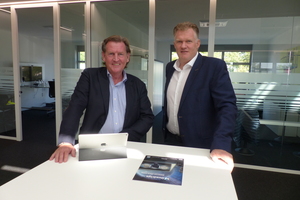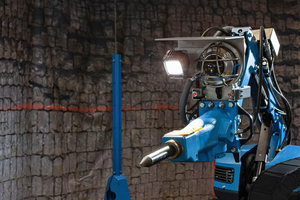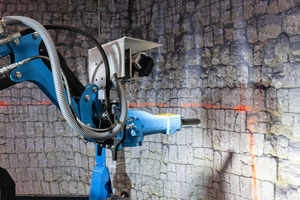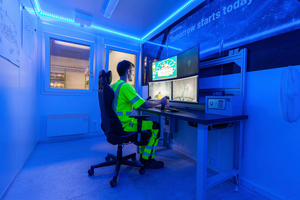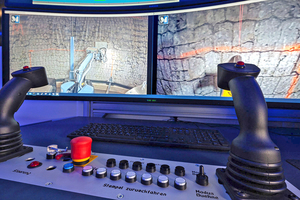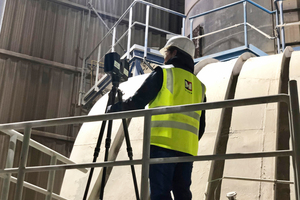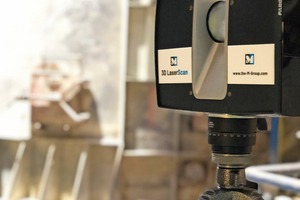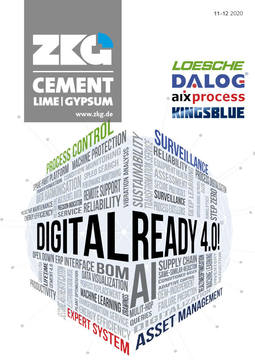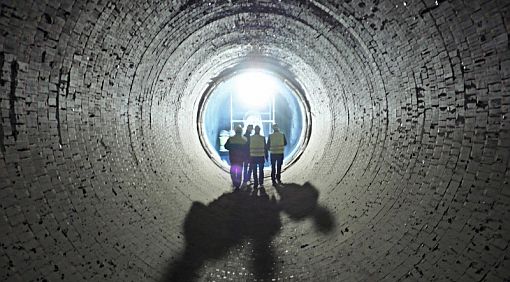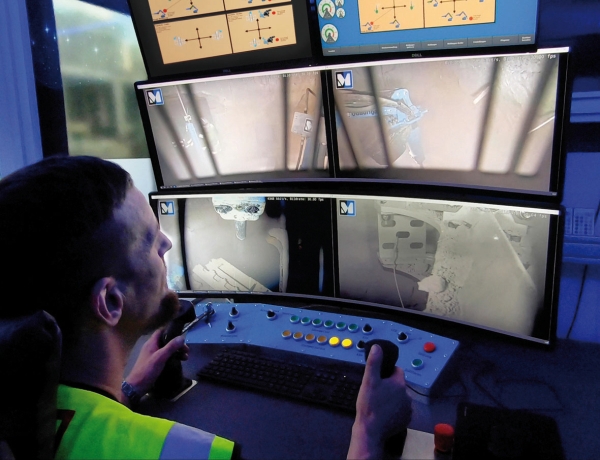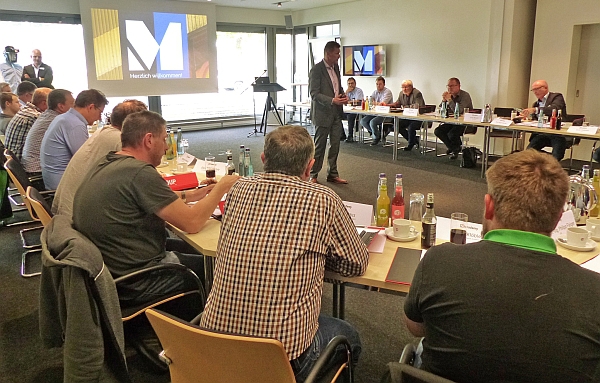Analog meets digital
The M-Group, headquartered in Lemgo/Germany, is made up of three main business areas interacting with each other: Refractory technology (Möller), lime kiln technology (Eberhardt Schwab) and safety technology (RefraSolid). ZKG Cement Lime Gypsum talked to Klaus Röpke, CEO, and Stefan Sasse, COO, about the development of the company during the Corona pandemic as well as the company’s latest innovation in the refractory unit.
Röpke: The background to the changes was the need to bring in a new generation, which I personally had been thinking about for a long time. We sourced inside and outside, and then relatively quickly came across Stefan Sasse, who has been with the company for over 20 years, most recently as sales manager. As COO, Mr. Sasse is now completely responsible for the operative business. In addition to Mr. Sasse, the management board now consists of the commercial director (CFO) Marius Pixa and myself as CEO. This constellation has existed since 1 May 2020 and is functioning very well.
Röpke: First of all, we’re extremely glad that we haven’t had a Covid 19 case within the company yet, despite the fact that we have 180 employees worldwide.
Fortunately, we were able to react quickly to the crisis because we have an extensive IT infrastructure that enables us to work from our home offices for the most part.
We turned to virtual meetings. Like many others, we were forced to improve our digital presence. Fortunately, however, the majority of the projects were only postponed, not cancelled. Up to now, the Corona crisis has not hit us so hard. We have had to make some adjustments, but we expect the situation to stabilize somewhat in the next year or two, provided that there are no further lockdowns1.
Sasse: In many ways we have been lucky. When the lockdown came, the necessary repairs in the cement sector had been finished, so we had already completed a large part of the business of our main season between January and March and the cement plants were all back in operation. As a construction service provider we were classified as systemically relevant, and so we were able to continue our work despite all organizational difficulties.
What we then had to struggle with was the uncertainty among our customers. Repairs were postponed, and many companies also simply did not want to have any outside employees on their premises. In theory, we could have worked on, but customers were uncertain and wanted to wait and see. But relatively quickly, many of them realized that they had to continue production and stay working, so that their plants had to be repaired. In this respect, we were able to start our work again quite quickly, at least in Germany.
However, international business became more problematic. It naturally became difficult for our employees to travel to construction sites abroad. We still had fitters in Russia, for example, with whom we could finish existing work at the construction sites, but nobody was allowed to enter the country, so we could not take on any new work. In addition, things happened that people had never thought about before: employees were stuck in Russia because there were simply no flights. We solved this problem by chartering a private plane to get our people back.
In other countries we had problems due to entry restrictions or suddenly invalid visas, which meant that we couldn’t reach the construction sites at all. Even if the customers wanted us to travel to their plants, even if foreign ministries or ambassadors sometimes granted us special permits and official invitations with which we could theoretically have travelled to the countries, there were simply no flights – this situation would have been unthinkable a year ago.
The time and effort involved is enormous. Especially in our operational planning sector our people have to find out which flights are available, what entry restrictions apply, what documents are required. Meanwhile, this work consumes not only hours, but whole days and weeks. Fortunately, we have an experienced specialist from the travel industry on our staff who organizes everything for us, which of course helps us enormously.
But the bottom line is that we have always been able to continue in work, and we can also work currently. If we complain now, we are doing so from a comfortable position, compared to other industries.
Röpke: Digitalization has not only had an impact in the area of organizational measures, but has also led us to focus even more closely on work at our construction sites. We have questioned whether it is a viable model for the future to staff construction sites with 50, 60 or 70 fitters, sometimes working 24 hours a day, 7 days a week in day and night shifts. During the peak season in the cement industry, one can see that all companies employed there are working at full capacity. That’s why we wanted to think seriously about digitalization, since the accessibility of construction sites as we knew it in the past will probably no longer be possible in the future.
So we revisited plans and considerations that we already had before the Corona pandemic. We have used the time and space that we gained to think constructively about innovations.
Sasse: In the refractory sector, we perform a purely manual activity; as a craft enterprise, we work on site with our hands and hand tools. In view of the extremely high personnel input this involves, and the need for travel, we asked ourselves how our work can be managed and set up differently using digital technology.
In addition, it is becoming increasingly difficult to recruit personnel for such work at all, as the aspirations of young people have changed significantly. There is currently no longer much desire to take on jobs involving assembly and fitting, physical labor, and craftsmanship. We do not want to reduce our personnel, but rather ensure that we can continue to carry out our work. And to this end, we are increasingly focusing on the use of machines and equipment, as well as digitalization.
While digitalization has taken place in many industries in recent years, this has not been the case in the construction industry. If we look at building construction, we are basically still building today like the cathedrals were built in the Middle Ages. Today we use slewing cranes instead of treadwheels for transporting bricks to the top of a building, but the actual handicraft activities have not changed. The efforts, the labour has basically remained, it is still a manual activity. If you now transfer this to refractory construction, this situation is further compounded by the fact that we are a very small sector. For machine, equipment and plant manufacturers we are not the target market, and they are therefore not likely to develop innovations for such a small and limited industry. We work in narrow vessels and confined spaces, so that the use of machines is relatively difficult anyway. Large cranes and conveying equipment do not actually exist for our field of activities. One of the few work simplifications which there has been in recent years, or centuries actually, was the conversion from the 50-kg to the 25-kg cement bag.
In the long term, we will not be able to continue the business in the same form because we will also not be able to recruit a next generation of workers. If we want to do something to counteract these issues, we will have to do it ourselves. Disruption is now all around and we asked ourselves what developments could destroy our business model. What can we do to mitigate these trends and make the whole thing future-proof through digitalization and the use of machines? This is what led to our Quadriga System.
Sasse: Quadriga is currently still a partially automated system, with which we will be able to carry out refractory work on a fully automated basis in the future. We are not just talking about installing refractory bricks or spraying concrete, but about a comprehensive system. The name Quadriga stands for the four customer benefits of the system:
1. Extremely high occupational safety: If no one is working in the hazard zone, this source of danger is eliminated.
2. A massive saving of time: Since the automated brick installation and demolition options are significantly faster than the conventional manual methods.
3. A substantial reduction in costs: We can offer the customer a significant simplification of the process. The very dangerous and time consuming scaffold errection will be avoided completely.
4. We offer everything from a single source: Until now, multiple processes and different participating companies have had to be coordinated. We take over the entire process from cleaning, scaffolding and demolition to installation of the new lining. Fast, safe and with little time and effort on site.
Sasse: When we introduced the system, we were bound by a number of constraints. Since large events were not possible due to the Corona pandemic, we were not able to present the system in the grand style that we had planned.
We specifically addressed our customers in order to introduce the system to them. Their interest has been extremely positive, so that we are now holding very concrete talks to plan future applications of the system. Of course we are still busy with modifications, with training our staff and working on further developments, but we have already come to the conclusion that we need more of these systems in order to meet the great customer demand and interest.
Moreover, we had also registered the system for a patent. Since the patent application process has been completed in the meantime, we are now allowed to present and publish the system.
The good customer response shows that you are on the right track.
Sasse: We obviously hit the nail on the head with the topics of occupational safety, time and cost savings and process simplification. For our customers it is certainly also very interesting that we can provide all services from a single source. They don’t have to bother about anything: we come, do everything, disappear again at some point and ideally the customer has hardly even noticed that we were there.
In addition, we will also have to think about new material concepts in the future. Up to now, a brick has had a certain size, shape and weight so that it can be easily handled manually. In former times the bricks were placed by hand, sometime later a wooden arch was placed underneath the brick lining in the rotary kiln, until finally brick lining devices with pneumatic rams were developed. The materials have remained the same, only they are now installed with machine assistance. But if the materials were to change at some point, this would be the future perspective for us.
Röpke: With this activity, you can’t say, humans out, machine in; it won’t work. There will be a transition phase, but the thought behind our development of the Quadriga System was less to elimintate the craftmenship, and more how to make the job easier and safe in order to protect the humans. The demolition work, for example, is very strenuous and dangerous. In the future, the whole thing will be controlled on the monitor screen, so that the workers’ health is no longer so severely affected. For one thing, the personnel are protected from long-term harm, for example due to chromate, since they are in a separate room and are no longer exposed to pollutants.
Sasse: If I wear a helmet as a personal occupational safety measure, I am protected, but the hazard is not eliminated. Our approach is therefore that we do not want to allow hazard sources to arise in the first place. We have solved this by having a machine do the work in the hazard zone while the machine operator sits in an air-conditioned container, where he is neither at risk nor in the way of anyone.
Of course we need highly qualified personnel who can operate these devices. But they must already be trained refractory specialists, so that they know what they are doing. They must also be familiar with hydraulics and electronics and be able not only to operate but also to maintain and repair these machines and devices. The qualifications that we will need in the future will be completely different from those we have needed up to now. However, we are currently discovering that we can find people for this purpose. We have now trained the first people from our own ranks who have grown up in the refractory sector. So we are not cutting back on personnel, but rather providing them with further training to meet the new requirements. The response has been entirely positive and the employees are highly motivated. This can also be seen during the demonstrations for customers, when they enthusiastically explain their work with the Quadriga System.
Röpke: For the time being, we are doing this on our own, training the personnel and defining the new job description ourselves. Some time ago, we created the M-Academy, in which we provide in-house training.
Sasse: We now need really good teams, people who have the technical knowledge to assess the consequences. We no longer need 20 bricklayers, but one operator for the machine. But we also need an engineer or technician who is there for the maintenance and repairs. This means that we really need mixed teams with professional competence, actually a variety of qualifications and specialists in multiple individual fields.
Röpke: The Corona crisis increased everyone’s willingness to get involved in new things. Some people are happy at first to work from the home office, but after a few months they realize that personal interaction and social contacts are also important. A good mixture of digital solutions, personal exchange and solid craftsmanship is needed. So “analog meets digital”, but not “digital kills analog”, because both have to go hand in hand.
What plans do you have for the coming year?
Sasse: If we stay with the subject of Quadriga for the time being: At the moment, the Quadriga System has actually already done away with the need for scaffolding, the system can demolish the refractory lining and it should be able to spray concrete. We are currently working on this. This is still one of the big homework assignments that we have ahead of us for the next few months. A further step for the future of the Quadriga System is the transition from partial to full automation. We decided to build the Quadriga System modularly so that we could continue to adapt it to our requirements. In time it will certainly become even smaller, faster and more digital.
Röpke: In the future, it is planned to make 3D scans on site in order to record construction site data and analyze damage patterns and whatever problems the customer may have.
Sasse: In a way, we are certainly destroying our current business model. Because we can at present live quite well from the fact that we carry out repairs and actually send our employees out to repair rotary kilns in which, for whatever reason, bricks have fallen out of the refractory lining. We lived well in this way in the past and it is our business at the moment. However, we do not really want to help the customer when it is too late, but rather to act before it is too late, try to avoid actual repairs, reduce the number of repair operations. We would like to help the customer to achieve higher plant availability, so that he can plan repairs better or even do without a large part of the repairs, since digital technology will enable us to properly analyze why such damage has occurred and will thus put us in a position to eliminate the origins of the problems in advance. In this way, we want to distinguish ourselves from our competitors in the market by taking different routes, offering the customer a consulting service, an engineering service and a competence that helps him as far as possible to avoid or not to require our actual work assignment.
Röpke: We do this on the side, in addition to our daily business, which is not always easy. We get support from the University of Applied Sciences Ostwestfalen-Lippe here in Lemgo, with its affiliated Fraunhofer Application Center for Industrial Automation (IOSB-INA). We have worked closely with these institutions, particularly with regard to the automation of the Quadriga System. Local experts are a great help, including those from the Technology Campus for Intelligent Automation, the so-called SmartFactoryOWL.
Sasse: These are our ideas in the refractory division. In the area of plant engineering, i.e. in the Eberhardt Schwab lime kilns division, we are converting kilns from coke to gas firing in order to reduce CO2 emissions. For this purpose, we have developed the “Let’s go green” campaign, in order to realize far greener kilns for our customers or to retrofit old kilns. In the case of conventional lime kilns, the market is saturated, the kilns keep running and do so for a long time. How can we further develop a technology that is well over 100 years old and make it future-proof? What can we optimize through digitalization, by changing the firing system, to make these kilns really fit for the future, to save fuel, minimize CO2 emissions and ensure that they comply with legal requirements. We want to position ourselves differently in the future. Our claim is: “Tomorrow starts today”.

